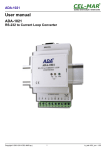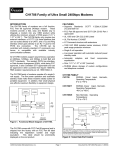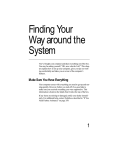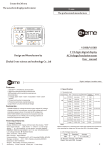Download DAM-3215 User`s Manual
Transcript
DAM-3215 User’s Manual Beijing ART Technology Development Co., Ltd. DAM-3215 User’s Manual V6.10 DAM-3216 Module Overview of Module Function DAM-3215 uses advanced optical isolation technology, to protect the RS-232 serial interface device, and avoid to damage the RS-232 equipment by the reason of ground loop voltage, surges, lightning, static electricity, hot swap and other harsh environment. DAM-3215 can effectively absorb the electrostatic and electromagnetic interference, protect devices RS-232 interface. DAM-3215 uses isolation technology, it can completely isolated electrical of the RS-232 devices and the circuit of the ground, make the electrical signals of one side into the optical signals, then transmitted to the other side, and last changed it to the electrical signals, thereby protecting communications equipment to avoid the damage because of the interference of the power ground loop and surges, improve the reliability and stability of communication system. Module Structure Module Features ¾ Interface: compatible with EIA RS-232 and CCITTV.24 asynchronous protocol ¾ Transfer Mode: asynchronous full-duplex, transparent ¾ Isolation Voltage: 500V or 2500V continuous pulse ¾ Communication Speed: up to 38.4Kbps ¾ Power: RS-232 port supplies power (TXD, RTS, or DTR) ¾ Dimension: 63mm × 33mm × 17mm ¾ Operating Environment: -40 ℃ to 85 ℃, relative humidity 5% to 95% 2 DAM-3215 User’s Manual V6.10 Connector RS-232C DTE pin assignment DB9(PIN) RS-232C Interface 1 Protective earth 2 Sending data, TXD 3 Receiving data, RXD 4 Data terminal ready, DTR 5 Ground (GND) 6 Data unit is ready, DSR 7 Request to send, RTS 8 Clear to send, CTS 9 Ringing RI RS-232C DCE pin assignment DB9(PIN) RS-232C Interface 1 Protective earth 2 Receiving data, TXD 3 Sending data, RXD 4 Data terminal ready, DTR 5 Ground (GND) 6 Data unit is ready, DSR 7 Request to send, RTS 8 Clear to send, CTS 9 Ringing RI Common Faults and Exclusion Method 1. Data Communication Failure ¾ Check the RS-232 interface, whether the wiring is correct. ¾ Check the RS-232 output interface, whether the wiring is correct. ¾ Check whether the terminals are connected well. 2. Data loss or errors ¾ Check the transfer rate and the format are consistent of the data communications equipment at both ends. 3








